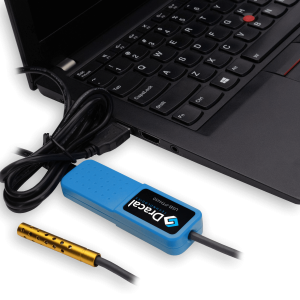5 Factors Impacting the Implementation Time of a Measurement System

Implementation time can be a critical deciding factor when choosing a measurement instrument. Here are five criteria that impact the implementation time of a measurement system to guide you in your search for the ideal system.
Here is an explanation of these factors and the various possible options.
1. Type of Instrumentation Used
- Transducer and Sensor
A transducer converts one form of energy into another. For example, a sensor detects a physical quantity, such as temperature or pressure, and converts it into a usable signal, often electrical. A sensor is a specific type of transducer. Implementing this instrumentation can be quick if a supporting system is already in place.
However, if no infrastructure is already in place, these instruments become time-consuming to implement, especially if no data access facilitation is available.
- Data Logger
A data logger is an all-in-one device that collects, records, and stores data. It consists of a sensor, a converter, and memory.
A data logger can provide a quick solution, mainly when used individually. However, harmonizing data from multiple data loggers can become tedious if no harmonization mechanism is supported.
2. Method of Accessing Recorded Data
- Data Acquisition System (DAQ)
A data acquisition system includes an acquisition interface that connects to the measurement instruments and software that allows data recording and storage. The data is already available on a computer or server, ready to be manipulated.
Implementing a DAQ system is not instantaneous. However, there are fast solutions (within 1 hour) and more standard solutions (several days), each offering advantages and disadvantages. If time is a concern for your project, investing some time to evaluate the available options will be beneficial.
- Individual Files
This is generally the format returned by individual data loggers. While their use is quick for individual usage, the time required to harmonize multiple files often outweighs the initial time savings.
3. Method of Combining Data
Regardless of the chosen data collection method, you must combine and harmonize the data using multiple sensors. Some software solutions can automatically perform this task, saving significant time. Generally, a good DAQ solution will provide data harmonization capabilities for the collected data.
Alternatively, combining data from multiple sensors manually is possible, but this will take several hours each time data analysis is required. This is not a viable solution for recurring tasks of analyzing and interpreting data from a complete system.
4. Method of Data Integration
The time required to integrate data into other software is accelerated based on the presence or absence of the following aspects:
- Existence of programming libraries, drivers, or application programming interfaces provided by the manufacturer.
- Availability of adequate documentation for their usage.
- Use of programming languages suitable for your working environment.
5. Available Resources
If you are a metrologist with limited programming knowledge, you may need access to a developer to implement a measurement system quickly. If you are a test engineer, you probably have experience with programming languages. Ensure the chosen system is programmable in your usual language to facilitate its implementation. Investing resources at the beginning of the project can save a lot of debugging time later.
Where Does Dracal Fit in These 5 Criteria?
1. Type of Instrumentation Offered
Dracal offers measurement instruments where the sensor/transducer is integrated, although they are not equipped with a data recording system. The measurement instrument also includes a converter. All these electronic components are assembled in a housing with a USB port.

2. Method of Data Collection
The Dracal solution is a data acquisition system. You can instantly record your data with our measurement instruments, a computer, and the free software suite.
The SensGate, on the other hand, allows remote data collection from instruments connected to the same network.
3. Method of Combining Data
Dracal's Mix & Match measurement system automatically harmonizes all data from your instruments, regardless of their types.
4. Method of Data Integration
The software integration of Dracal's measurement instruments can be done via the following:
A) Command-line tools (simplified integration).
B) Our Python API (for experienced developers, planned for September 2023!).
C) Virtual serial port communication mode (integration without third-party software).
5. Available Resources
Tutorials, user guides, and documentation are available for our tools. In addition, the variety of integration tools allows integration by test engineers and experienced software developers. Therefore, an IT or developer team is optional to implement a Dracal system.